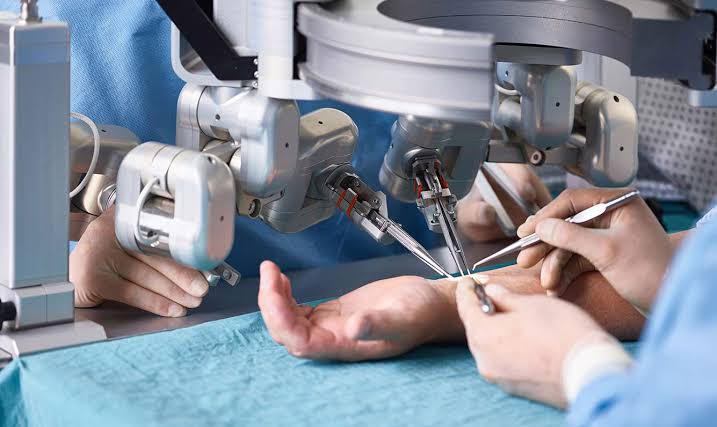
Robotic Surgery and Precision Medicine
Robotic surgery and precision medicine are revolutionizing healthcare by combining cutting-edge technology with personalized treatment. Robotic systems enhance surgical precision and reduce recovery times, while precision medicine customizes therapies based on genetic and molecular patient data. Together, they improve outcomes in complex diseases like cancer and heart conditions.
✨ Raghav Jain

Introduction
The future of healthcare is rapidly evolving with groundbreaking technologies transforming how diseases are diagnosed and treated. Two of the most promising advances are robotic surgery and precision medicine. These innovations not only increase the accuracy and effectiveness of treatments but also minimize risks, reduce recovery times, and personalize care for every patient.
While robotic surgery involves using robotic systems to assist surgeons during complex procedures, precision medicine focuses on tailoring medical treatments based on an individual's unique genetic makeup, environment, and lifestyle.
In this article, we will explore how robotic surgery and precision medicine work individually and together to revolutionize healthcare, their benefits, challenges, and how they’re shaping the future of medicine. The convergence of robotic surgery and precision medicine represents a monumental leap forward in healthcare, ushering in an era of unprecedented surgical accuracy and highly personalized treatment. While both fields are revolutionary on their own, their integration creates a symbiotic relationship where the enhanced capabilities of robotic technology can be precisely guided by the individualized data of precision medicine, leading to better patient outcomes, faster recovery, and more targeted interventions. Robotic surgery, often more accurately described as robot-assisted surgery, is a minimally invasive technique where a surgeon controls a sophisticated robotic platform with high-definition 3D cameras and articulating arms. This technology provides a surgeon with a magnified, clear view of the surgical site and a range of motion that far exceeds the capabilities of the human wrist, all while filtering out any natural hand tremors. The resulting precision allows for delicate and complex procedures to be performed through small incisions, significantly reducing blood loss, pain, and the risk of infection. This has transformed fields like urology, gynecology, and thoracic surgery, making previously difficult or impossible operations routine and allowing patients to experience shorter hospital stays and quicker return to their daily lives.
Precision medicine, on the other hand, is an innovative approach to disease treatment and prevention that takes into account individual variability in genes, environment, and lifestyle. Instead of a one-size-fits-all approach, it leverages detailed information from a patient's genetic profile, tumor DNA, and other molecular biomarkers to create a tailored treatment plan. For example, in oncology, precision medicine has revolutionized cancer treatment by identifying the specific genetic mutations driving a patient's tumor, allowing doctors to select targeted therapies that attack the cancer cells while minimizing damage to healthy tissue. This personalized approach to drug selection and dosage is a prime example of medicine moving from a reactive to a highly proactive and individualized model.
The true transformative power, however, lies in the intersection of these two disciplines. Precision medicine is providing the "what" and "why" of a patient's disease, and robotic surgery is providing the "how" and "where" for the most precise and effective intervention. The future of surgery is not just a robotic arm performing a task, but a robotic arm being guided by a patient's unique biological data. Imagine a scenario where a surgeon, using a robotic system, is preparing to remove a cancerous tumor. Prior to the operation, genetic sequencing has revealed the exact molecular boundaries of the tumor, and advanced imaging has provided a real-time, augmented-reality overlay on the surgical screen, highlighting the precise tissue margins that need to be excised. The robotic system could even be pre-programmed with this data, allowing it to perform with a level of accuracy that is impossible for human hands alone. Furthermore, this convergence enables more than just precision cutting; it facilitates the targeted delivery of drugs directly to the surgical site, or the in-situ application of therapies that are tailored to the patient's specific genetic makeup. For instance, a robotic arm could not only remove a tumor but also deliver a personalized, gene-editing therapy to the surrounding cells to prevent recurrence, all based on the patient's individual genomic data. The integration of artificial intelligence and machine learning further enhances this synergy, as AI algorithms can analyze the vast datasets from precision medicine and intraoperative data from the robotic system to provide surgeons with real-time, predictive insights during the procedure. This continuous feedback loop creates a dynamic and intelligent surgical environment, where decisions are not only based on a surgeon's skill but are also informed by a profound understanding of the patient's unique biology. The challenges to this integration, such as the high cost of technology, the need for extensive surgeon training, and the paramount concerns of data privacy and cybersecurity, are significant. However, the promise of a future where every surgical intervention is not only minimally invasive but also a perfectly tailored, data-driven attack on disease, makes the continued investment and innovation in this field a cornerstone of modern medicine. This fusion of robotics and personalized data is not merely a technological advancement; it is a fundamental shift toward a more effective, safer, and truly patient-centric model of care.
Understanding Robotic Surgery
Robotic surgery is a type of minimally invasive surgery where surgeons use robotic arms controlled via computer consoles. These systems provide enhanced precision, flexibility, and control beyond human capabilities.
Key components of robotic surgery include:
- Robotic arms: Equipped with surgical instruments and cameras
- 3D high-definition visualization: Gives surgeons a magnified view of the operation site
- Surgeon console: Where the surgeon controls the robot with hand and foot controls
- Computer assistance: Enhances steadiness and reduces hand tremors
Popular robotic surgery systems: da Vinci Surgical System, ROSA, MAKO
Advantages of Robotic Surgery
- Increased Precision
- Robotic instruments have a greater range of motion than human hands and can perform delicate movements with tiny incisions.
- Reduced Trauma
- Smaller incisions mean less blood loss, reduced pain, and minimal scarring.
- Shorter Hospital Stay
- Patients usually recover faster and return home sooner compared to traditional open surgery.
- Better Visualization
- High-definition 3D cameras allow surgeons to see tissues and organs clearly.
- Reduced Risk of Infection
- Minimally invasive nature lowers chances of postoperative infections.
What is Precision Medicine?
Precision medicine (also called personalized medicine) is an approach that customizes healthcare based on individual differences in genes, environment, and lifestyle. Unlike traditional one-size-fits-all treatments, precision medicine identifies the most effective therapies for a specific person.
Main tools in precision medicine:
- Genetic Testing: Identifies gene mutations, susceptibilities
- Biomarkers: Detect disease indicators at molecular level
- Big Data & AI: Analyze large datasets to predict outcomes
- Pharmacogenomics: Tailors drug therapy based on genetic response
How Precision Medicine Works
- Patient Profiling: Collect detailed genetic, environmental, and lifestyle data.
- Disease Classification: Understand the exact subtype or mutation causing illness.
- Targeted Therapy Selection: Choose treatments that specifically target genetic mutations or pathways.
- Monitoring & Adjustment: Track response and adapt treatments in real-time.
Benefits of Precision Medicine
- More Effective Treatments: Higher success rates by targeting root causes.
- Reduced Side Effects: Avoid drugs that won’t work or cause harm.
- Early Disease Detection: Identify risks before symptoms appear.
- Preventive Care: Tailor lifestyle and screening recommendations.
- Improved Patient Outcomes: Better quality of life and longer survival.
Robotic Surgery + Precision Medicine: The Future of Healthcare
Together, robotic surgery and precision medicine create a powerful synergy that’s reshaping medical care.
1. Personalized Surgical Planning
Precision medicine helps understand the exact nature of a disease (like tumor genetics), allowing surgeons to plan the procedure specifically for each patient’s unique condition.
2. Enhanced Surgical Accuracy
Robotic systems execute these plans with extreme precision, minimizing damage to healthy tissue and improving recovery.
3. Real-Time Data Integration
During robotic surgery, precision medicine tools can provide live feedback on biomarkers or tissue health, guiding surgeons instantly.
4. Reduced Complications
Personalized treatment reduces risks of rejection or adverse reactions post-surgery.
5. Faster Recovery and Better Outcomes
Minimally invasive robotic surgery combined with targeted therapies results in quicker healing and long-term disease control.
Daily Practices and Considerations in Precision Surgical Care
- Pre-surgery: Genetic testing and imaging to customize surgical plans
- During surgery: Use of robotic tools for delicate procedures
- Post-surgery: Targeted medication and lifestyle changes based on patient’s profile
- Follow-up: Regular monitoring with precision diagnostics for early detection of recurrence
Challenges and Limitations
- High Costs: Robotic systems and genetic testing are expensive.
- Training Requirements: Surgeons need specialized skills to operate robotic systems.
- Data Privacy: Managing sensitive genetic data securely is critical.
- Accessibility: Advanced treatments may not be available everywhere.
- Ethical Concerns: Genetic information use requires careful regulation.
Common Myths About Robotic Surgery and Precision Medicine: Busted!
“Robotic surgery means robots perform surgery alone.”
→ False! Robots assist surgeons; humans control every movement.
“Precision medicine is only for cancer patients.”
→ Wrong! It’s used for many conditions including heart disease, rare disorders, and infections.
“These technologies are too futuristic and not proven.”
→ Incorrect. Robotic surgery and precision medicine are already FDA-approved and widely practiced.
“Robotic surgery means no risks.”
→ All surgeries have risks; robotics reduces but doesn’t eliminate them.
Sample Patient Journey Using Robotic Surgery & Precision Medicine
StageActionBenefitsDiagnosisGenetic testing and imagingDetailed disease understandingSurgical PlanPersonalized robotic-assisted surgery setupPrecise, minimally invasive surgerySurgeryRobotic procedure with real-time monitoringReduced trauma, accurate excisionPost-op CareTargeted drug therapy based on geneticsFewer side effects, better healingFollow-upMolecular monitoring and lifestyle adviceEarly detection of recurrence
Conclusion
Robotic surgery and precision medicine are revolutionizing the way we approach healthcare. By combining cutting-edge technology with personalized treatment plans, patients receive care that is safer, more effective, and tailored uniquely to them.
These advancements represent a shift from generalized medicine to a patient-centered future—where every treatment decision is informed by data, precision, and compassion.
Whether you’re facing surgery or exploring preventive care, understanding these technologies empowers you to make informed choices and embrace a new era of health.
Start exploring the possibilities with your healthcare provider and witness the incredible benefits of robotic surgery and precision medicine firsthand.
Q&A Section
Q1:- What is robotic surgery and how does it differ from traditional surgery?
Ans :- Robotic surgery uses advanced robotic systems controlled by surgeons to perform minimally invasive procedures with enhanced precision, flexibility, and control compared to traditional open or laparoscopic surgery.
Q2:- How does precision medicine personalize treatment for patients?
Ans :- Precision medicine tailors healthcare by analyzing an individual’s genetic makeup, lifestyle, and environment to design customized treatments that are more effective and have fewer side effects.
Q3:- What are the main benefits of robotic surgery for patients?
Ans :- Patients experience smaller incisions, reduced blood loss, less pain, quicker recovery times, and lower risk of infection due to the minimally invasive nature of robotic-assisted procedures.
Q4:- How do surgeons control robotic surgery systems during operations?
Ans :- Surgeons use specialized consoles with high-definition 3D visualization and precise hand controls to manipulate robotic instruments remotely, enabling delicate movements beyond human hand capability.
Q5:- How does precision medicine improve cancer treatment outcomes?
Ans :- By identifying specific genetic mutations and biomarkers in tumors, precision medicine allows oncologists to choose targeted therapies that directly attack cancer cells while sparing healthy tissue.
Q6:- What role does AI play in advancing robotic surgery and precision medicine?
Ans :- AI enhances robotic surgery through real-time image analysis and decision support, while in precision medicine, it helps interpret complex genetic data to guide personalized treatment plans.
Q7:- Are there limitations or risks associated with robotic surgery?
Ans :- Despite many advantages, robotic surgery requires specialized training, can be costly, and carries risks like any surgery, including potential mechanical failure or longer operation times during learning curves.
Q8:- How does robotic surgery benefit complex procedures like heart or prostate surgery?
Ans :- It allows for highly precise maneuvers in tight spaces, reducing trauma to surrounding tissues and improving surgical accuracy, leading to better patient outcomes in complex operations.
Q9:- What technologies enable precision medicine to analyze individual patient data?
Ans :- Genomic sequencing, biomarker analysis, big data analytics, and bioinformatics tools enable the comprehensive understanding of a patient’s molecular and clinical profile.
Q10:- How are robotic surgery and precision medicine shaping the future of healthcare?
Ans :- Together, they are driving a shift toward less invasive, highly personalized, and more effective treatments, improving patient safety, outcomes, and healthcare efficiency globally.
Similar Articles
Find more relatable content in similar Articles

How Wearable Devices Detect Hu..
Wearable devices use biosenso.. Read More

Top AI Applications for Design..
AI is revolutionizing social .. Read More

The Role of AI Facial Recognit..
AI facial recognition is revo.. Read More

Hyperloop Technology: A Game-..
Hyperloop technology envision.. Read More
Explore Other Categories
Explore many different categories of articles ranging from Gadgets to Security
Smart Devices, Gear & Innovations
Discover in-depth reviews, hands-on experiences, and expert insights on the newest gadgets—from smartphones to smartwatches, headphones, wearables, and everything in between. Stay ahead with the latest in tech gear
Apps That Power Your World
Explore essential mobile and desktop applications across all platforms. From productivity boosters to creative tools, we cover updates, recommendations, and how-tos to make your digital life easier and more efficient.
Tomorrow's Technology, Today's Insights
Dive into the world of emerging technologies, AI breakthroughs, space tech, robotics, and innovations shaping the future. Stay informed on what's next in the evolution of science and technology.
Protecting You in a Digital Age
Learn how to secure your data, protect your privacy, and understand the latest in online threats. We break down complex cybersecurity topics into practical advice for everyday users and professionals alike.
© 2025 Copyrights by rTechnology. All Rights Reserved.